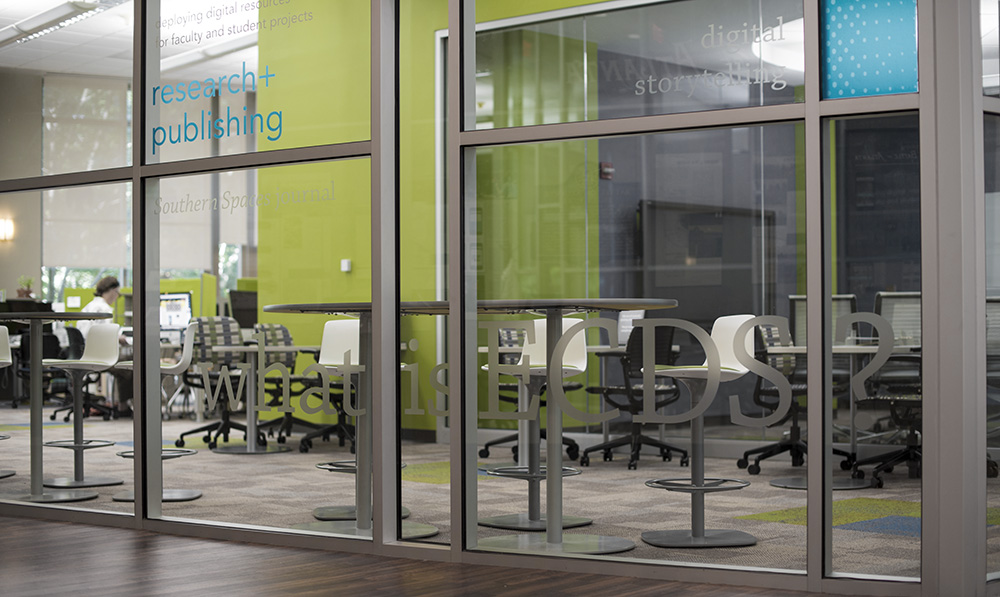Guest writer: Dr. Stephen Ross (University of Victoria). Dr. Ross was the recipient of the 2016 ECDS Digital Scholarship Residency and presented a public talk on his Linked Modernisms project and a pedagogy workshop on his Z-axis tool on March 2-3, 2016. Read about our residency program here.
In March 2016 I had the honour of serving as the first Resident in Emory University’s Center for Digital Scholarship (ECDS). It was an extraordinary experience, one that will have a lasting effect on my scholarship, research, and teaching.
The ECDS is situated in a gorgeous, bright, airy space in the very handsome Woodruff Library. This fact strikes me as critical: To my mind, libraries and digital labs belong together as key elements of humanities research. They are every bit as essential to the production of new knowledge as a giant microscope or state of the art particle accelerator. The ECDS’s proximity to the Stuart A. Rose Manuscripts, Archives and Rare Books Library, also located in Woodruff, facilitates precisely the sort of cross-disciplinary collaboration that is the lifeblood of Digital Humanities — and actually of humanities research tout court. Huge thanks to Ann Donlon for showing me around, and to Pellom McDaniels III who just happened to be strolling down the corridor when Meredith Doster and I corralled him for an impromptu chat about archives, finding aids, and innovative ways to showcase rare materials without putting the originals on public display. That conversation was a true highlight.
The ECDS is staffed by very personable graduate students, staff, post-docs, and faculty. My suspicion is that all that good cheer comes down to regular doses of cheesy grits and coffee from The Flying Biscuit. Shepherded by all-around fixer Anandi Salinas, I met with people working on all manner of projects, from Meredith Doster, managing editor of the digital peer-reviewed Southern Spaces journal to Jesse Karlsberg, who is helping develop the Readux platform for annotating PDF page images. In each case I was struck by the humility of the people doing this work (they seem not to know how good their work is, sometimes) and by their eagerness to consider yet more possible approaches and ways to develop things.
As a modernist myself, I was especially pleased to have the chance to sit down and talk turkey with Lois Overbeck on future plans for a digital companion to the massive Letters of Samuel Beckett project (4 volumes, from Cambridge UP). The work presently in hand presents almost limitless possibilities, and I’m eager to see how the ECDS proceeds with them. Stay tuned and watch this space for updates.
As much as I was enjoying learning about the work going on, it eventually became evident that the talk I had promised to give would actually be required of me. Entitled “The Mind of Modernism,” my research presentation (of which you can see the slides and hear the audio below) outlined the latest work we at the University of Victoria have done on Linked Modernisms — the open source, open access digital discovery and visualization tool we’ve built to enhance the Routledge Encyclopedia of Modernism. The audience was lively and abundant. I thoroughly enjoyed their incisive questions, and still appreciate the warm welcome they gave me. As we continue to develop Linked Modernisms, I’ll be drawing upon many of the comments and questions, as well as subsequent conversations pursued over cocktails.
The following day I met with Allen Tullos, Wayne Morse, Alan Pike, and others to talk pedagogy and programming. It was gratifying to see the ECDS taking such a lively interest in developing its certificate in digital scholarship, asking about what kinds of workshops and seminars seemed likely to be most useful, and exploring how they could best educate and serve librarians, faculty, and students. I think you’ll see some really terrific innovative initiatives coming from them in the near future.
In keeping with the pedagogy theme of day two, I conducted a seminar for around twenty participants, showcasing the Z-Axis Mapping tool and talking about how it could be used in the classroom. The participants were sharp, putting the tool through its paces and exploring — sometimes crossing — its limits. There were lots of excellent questions about how to add maps to the project and how to read the results. More cities for inclusion were suggested, and the possibility of adding a world map was mooted. I’m happy to report that we have started work on that side of things already, and that the input from that day has already yielded improvements to the site. Overwhelmingly, participants wanted more direction in terms of how to deploy the tool in the classroom setting — and since I’ve been back we’ve managed to post some sample assignments and lesson plans to the site as well: zaxis.uvic.ca
My only gripe about the visit is that it was all too short. The people in the ECDS are doing really great things and made the trip truly enjoyable. I’m keenly looking forward to working with them more. The Residency programme is just getting started, and I recommend it to anyone looking to experience the ideal combination of friendliness and rigor in a truly beautiful setting — and truly world-class cheesy grits, of course.
Watch Dr. Ross’ talk on Linked Modernisms
